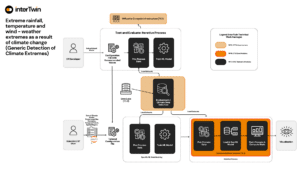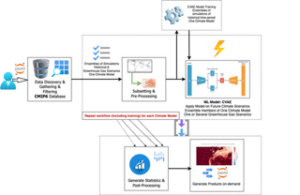Challenge
Solution


The development of this Digital Twin Application is very important for our climate research community, because it can leverage our climate simulations so that they can be exploited to their full potential by end users. The architecture provided by interTwin is really a key in making this application accessible to end users.
Christian Pagé, Research Engineer and Project Manager at CERFACS
Schematic overview of the main components of the DT Application: Extreme rainfall, temperature, and wind weather event changes in response to climate change. It uses a Convolutional Variational Auto-Encoder method to detect anomalies.

interTwin DTE Software Modules

Providing a python package implementing an unsupervised Deep Learning method, a Convolutional Variational Auto-Encoder (CVAE)...
An open-source service to enable transparent access to heterogeneous computing providers
...Providing a service that manages data locality. It provides a scalable solution for managing...

A Python library that streamlines AI workflows, while reducing coding complexity.
...
